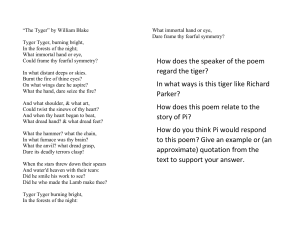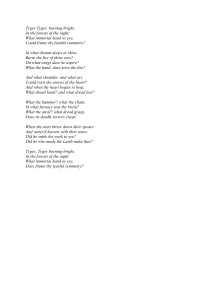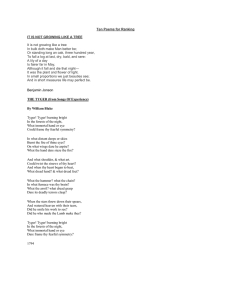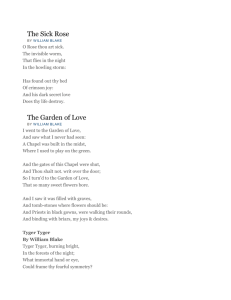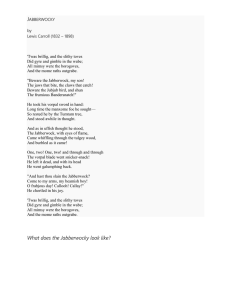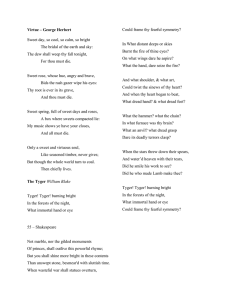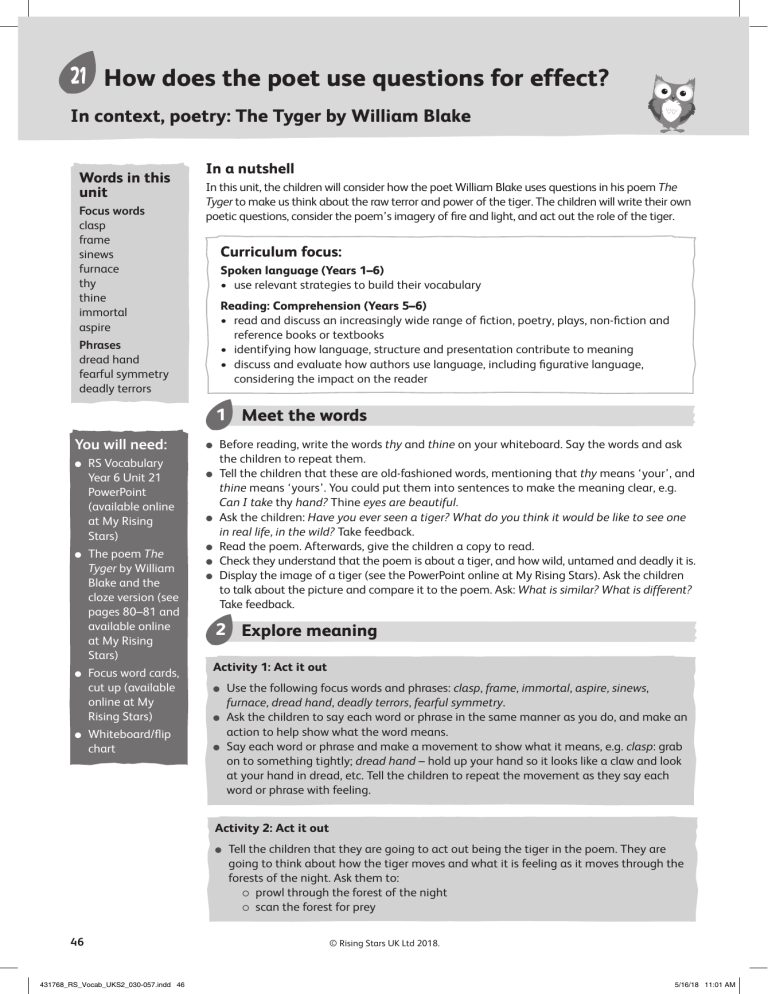
21 How does the poet use questions for effect? In context, poetry: The Tyger by William Blake Words in this unit Focus words clasp frame sinews furnace thy thine immortal aspire In a nutshell In this unit, the children will consider how the poet William Blake uses questions in his poem The Tyger to make us think about the raw terror and power of the tiger. The children will write their own poetic questions, consider the poem’s imagery of fire and light, and act out the role of the tiger. Curriculum focus: Spoken language (Years 1–6) • use relevant strategies to build their vocabulary Reading: Comprehension (Years 5–6) • read and discuss an increasingly wide range of fiction, poetry, plays, non-fiction and reference books or textbooks • identifying how language, structure and presentation contribute to meaning • discuss and evaluate how authors use language, including figurative language, considering the impact on the reader Phrases dread hand fearful symmetry deadly terrors 1 Meet the words You will need: l l l l RS Vocabulary Year 6 Unit 21 PowerPoint (available online at My Rising Stars) The poem The Tyger by William Blake and the cloze version (see pages 80–81 and available online at My Rising Stars) Focus word cards, cut up (available online at My Rising Stars) Whiteboard/flip chart l l l l l l Before reading, write the words thy and thine on your whiteboard. Say the words and ask the children to repeat them. Tell the children that these are old-fashioned words, mentioning that thy means ‘your’, and thine means ‘yours’. You could put them into sentences to make the meaning clear, e.g. Can I take thy hand? Thine eyes are beautiful. Ask the children: Have you ever seen a tiger? What do you think it would be like to see one in real life, in the wild? Take feedback. Read the poem. Afterwards, give the children a copy to read. Check they understand that the poem is about a tiger, and how wild, untamed and deadly it is. Display the image of a tiger (see the PowerPoint online at My Rising Stars). Ask the children to talk about the picture and compare it to the poem. Ask: What is similar? What is different? Take feedback. 2 Explore meaning Activity 1: Act it out l l l Use the following focus words and phrases: clasp, frame, immortal, aspire, sinews, furnace, dread hand, deadly terrors, fearful symmetry. Ask the children to say each word or phrase in the same manner as you do, and make an action to help show what the word means. Say each word or phrase and make a movement to show what it means, e.g. clasp: grab on to something tightly; dread hand – hold up your hand so it looks like a claw and look at your hand in dread, etc. Tell the children to repeat the movement as they say each word or phrase with feeling. Activity 2: Act it out l 46 431768_RS_Vocab_UKS2_030-057.indd 46 Tell the children that they are going to act out being the tiger in the poem. They are going to think about how the tiger moves and what it is feeling as it moves through the forests of the night. Ask them to: ¡ prowl through the forest of the night ¡ scan the forest for prey © Rising Stars UK Ltd 2018. 5/16/18 11:01 AM Year 6 show their strength as they roar stare at the sky ¡ return to their lair, feeling full of pride and power! Ask the children to discuss what it was like being the tiger. Show them the picture of the tiger again. Ask: How would you describe this picture now? Has it changed? Discuss together. ¡ ¡ l 3 Play with words Activity 1: Like a fire l l l l Ask the children to look at the poem and find all the words and phrases that link to fire or light. Take feedback, writing the words and phrases on the whiteboard. (burning bright, night, burnt the fire of thine eyes, seize the fire, furnace, stars) Show the children the image of the tiger and the image of fire (see the PowerPoint online at My Rising Stars). Ask the children to think about the links between the tiger and fire. How does the tiger look like a fire? How does it behave like a fire? The poet writes a lot of questions in the poem. Model making a fire-based poetic question about the tiger, e.g. What flame spreads from your eyes? Do you leave ashy footprints behind? Ask the children to create a poetic question for the tiger using fire or light. Take feedback. Activity 2: Change the poem l l l l Give the children the cloze version of the poem (see page 81 or the PowerPoint online at My Rising Stars). The poet uses the words fearful, dread, deadly and terror to describe the tiger. Ask the children to think of other words they know that have similar meanings. Write these words on the whiteboard for the children to refer to later on. Model changing one stanza of the poem, using some of the synonyms for terror and dread – you may wish to change some other parts of the stanza. Play around with new word choices. Which words work and which don’t? Can the children describe how the poem changes when new words are used? 4 Deepen understanding Ask the children to respond, calling out ‘deadly’ or ‘safe for now!’ when you say the following phrases. ¡ a great white shark hunting ¡ a scratch when you fall over ¡ a kitten playing with a feather ¡ eating too many sweets! ¡ the tiger stalking its prey ¡ a spider’s web when a fly is trapped in it Word wise challenge Ask the children to compose a new stanza for the poem. Tell them to use the image of the tiger and the poetic questions they have already written as a starting point for inspiration. Words at home Some animals make us feel very happy, or delighted, or even disgusted. Ask the children to think about an animal or insect that provokes a strong emotion in them, and then to come back and tell the class about it. © Rising Stars UK Ltd 2018. 431768_RS_Vocab_UKS2_030-057.indd 47 47 5/16/18 11:01 AM Year 6 Unit 21 Word_Card.indb 57 clasp thy frame thine sinews immortal furnace aspire You may photocopy this page. © 2018 Rising Stars UK Ltd. 5/15/18 5:05 PM dread hand deadly terrors fearful symmetry Year 6 Unit 21 Word_Card.indb 58 You may photocopy this page. © 2016 Rising Stars UK Ltd. 5/15/18 5:05 PM 21 The Tyger by William Blake Tyger Tyger, burning bright, In the forests of the night; What immortal hand or eye, Could frame thy fearful symmetry? In what distant deeps or skies. Burnt the fire of thine eyes? On what wings dare he aspire? What the hand, dare seize the fire? And what shoulder, & what art, Could twist the sinews of thy heart? And when thy heart began to beat, What dread hand? & what dread feet? What the hammer? what the chain, In what furnace was thy brain? What the anvil? what dread grasp, Dare its deadly terrors clasp! When the stars threw down their spears And water’d heaven with their tears: Did he smile his work to see? Did he who made the Lamb make thee? Tyger Tyger burning bright, In the forests of the night: What immortal hand or eye, Dare frame thy fearful symmetry? 80 431768_RS_Vocab_UKS2_070-084.indd 80 © Rising Stars UK Ltd 2018. You may photocopy this page. 5/16/18 11:39 AM 21 The Tyger by William Blake Tyger Tyger, ________ bright, In the forests of the night; What immortal hand or eye, Could frame thy ________ symmetry? In what distant deeps or skies. ________ the fire of thine eyes? On what wings dare he aspire? What the hand, dare seize the fire? And what shoulder, & what art, Could twist the sinews of thy heart? And when thy heart began to beat, What ________ hand? & what ________ feet? What the hammer? what the chain, In what furnace was thy brain? What the anvil? what ________ grasp, Dare its ________ ________ clasp! When the stars threw down their spears And water’d heaven with their tears: Did he smile his work to see? Did he who made the Lamb make thee? Tyger Tyger ________ bright, In the forests of the night: What immortal hand or eye, Dare frame thy ________ symmetry? © Rising Stars UK Ltd 2018. You may photocopy this page. 431768_RS_Vocab_UKS2_070-084.indd 81 81 5/16/18 11:39 AM
